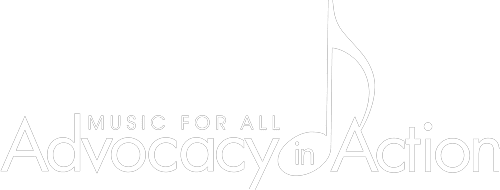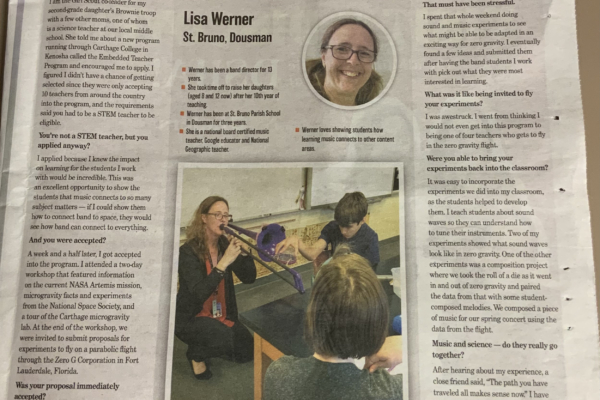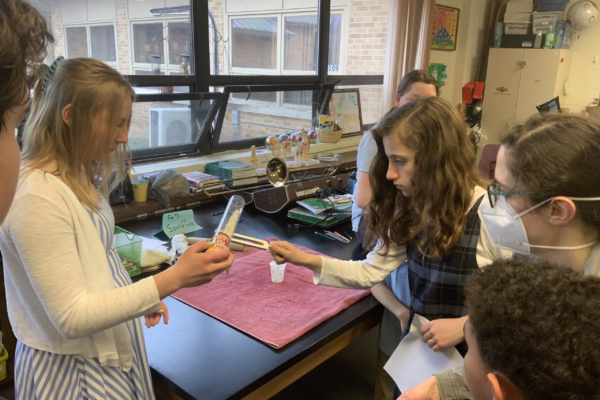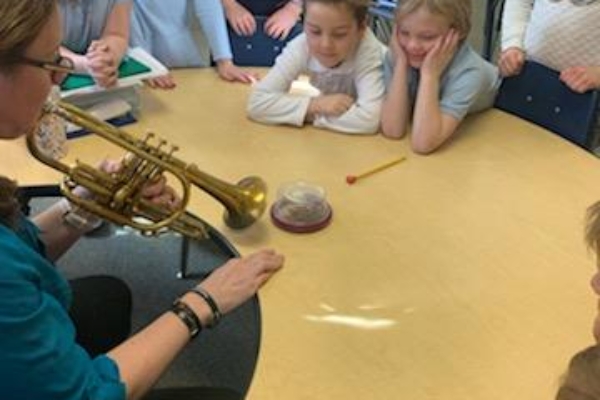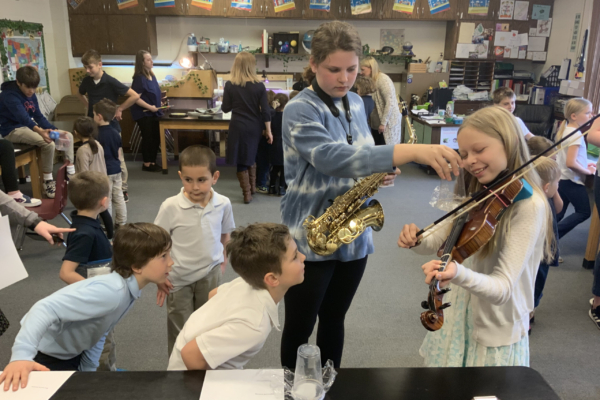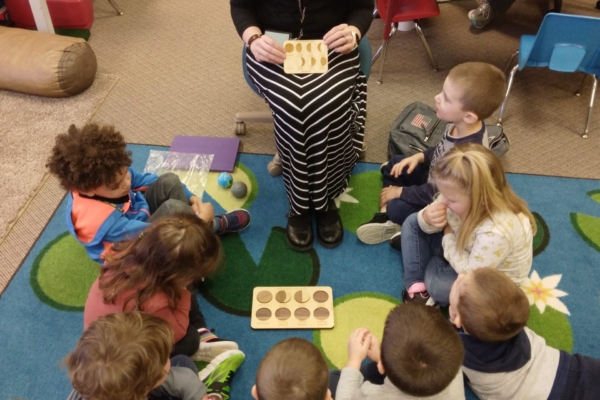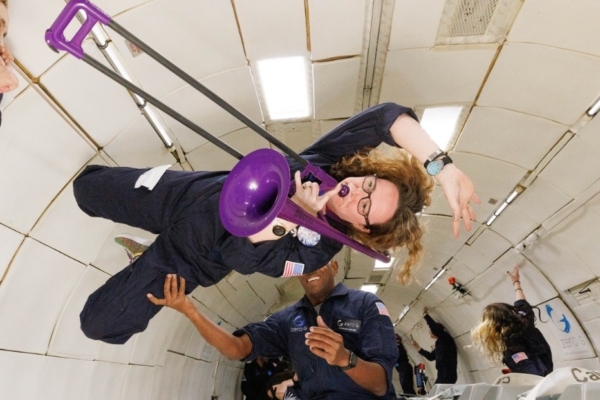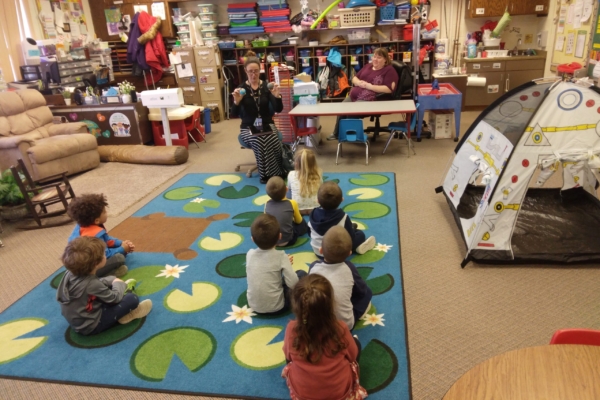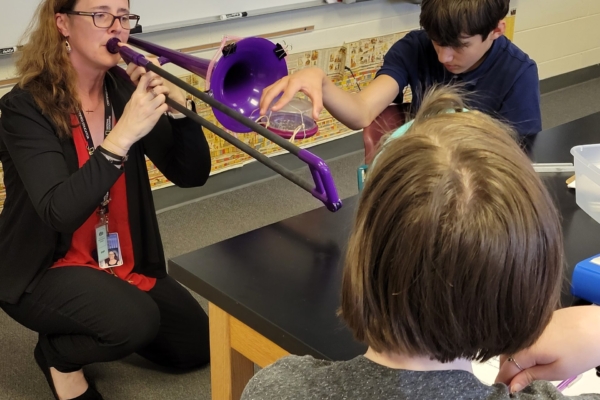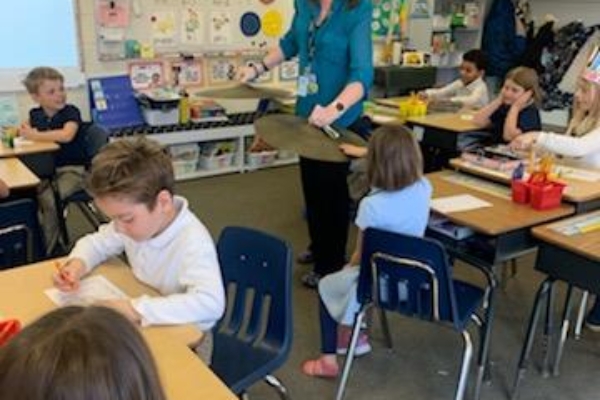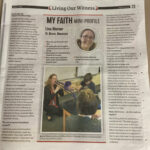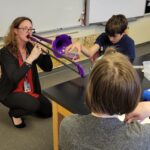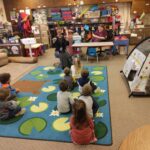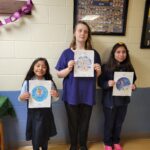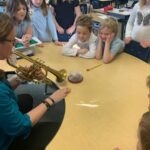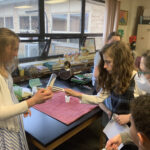“Mission S.O.S.I.T.A. (Sounds of Space In The Air): Taking Music to Zero Gravity”
St. Bruno Parish School Music Program
Dousman, WI
Description
Our advocacy initiative was to show our students and community how music plays a role in current space exploration experiments. Knowledge of how music and sound works is an important part of how spaceships are measuring their fuel tank capacity, due to how ineffective fuel sensors are in reduced gravity situations. Also, with long-duration space travel, music is an important part of space travelers’ mental health. Showing students and community members how important music is in space travel will lead them to understand the importance of music as a whole, and to help them draw other comparisons between other subjects.
Objectives
My main objective was to create a unique student engagement activity showing students the importance of music in the world outside of our school music program.
We did this by having students design microgravity experiments and music compositions related to sound and music for a zero gravity (parabolic) flight.
Other objectives included:
- Boosting student retention by showing students how music fits with other content areas
- Creating music from scientific data (using the rolls of a die in zero gravity to create a musical composition in the style of Chance Compositions credited to Mozart)
- Building a strong support of music through publicity of our advocacy initiative
- Building a strong base for music recruitment through exciting and energizing the younger students in our school
- Creating lifelong appreciation for music through the connection of music and other content areas
- Sharing the importance of music with community members
- Elevating music education’s strengths in an area of education that music might not regularly be thought of as important – sharing with STEM teachers how music education processes and pedagogy has a LOT in common with the same goals of STEM education (curiosity, team work, creativity, etc.)
Target Audience
I view the target audience for this initiative as a ripple effect-type project. The center of the ripple, and the most important target audience for this project was the middle school band students that I was teaching in class. They were the students who I work with regularly, and they were the students who designed the experiments we ran on the flights. I wanted to show these students that music is intertwined with every subject matter in an effort to continue to have strong retention and engagement in band classes. Rippling out from that was the entire school. I knew that this was a big opportunity, and that it shouldn’t just be about the band students in my school. I wanted to show the entire school the importance of music in this journey. I also knew that this helps to build excitement for music, and thus helps recruitment into our music programs. From there, I wanted to share with the community what we were doing. I feel it’s very important to communicate our successes and big projects to the community so that our music program is always on their minds and in their hearts. This project serves as a constant reminder of why music education is so important and how music connects people together in many different ways. An added bonus of our initiative was the opportunity to communicate our project with people in our part of the state through media coverage, and a national audience through the journals and presentations I’ve created, all serving as the outermost rings of the ripple of influence from this project.
Timeline
The project began in August 2021 when I applied for the Embedded Teacher Program workshop at Carthage College in Kenosha, WI. When I was accepted to the program, I attended the workshop on October 8 and 9, 2021. From there, the teachers were invited to propose experiments for consideration for a zero gravity (parabolic) flight. I proposed a set of student-created experiments in hopes of getting accepted on the November 2021 flights. I was denied. The students and I then worked through December (during Christmas concert season at our Catholic school) to design brand-new experiments for our proposal. We found out in January of 2022 that our experiments were invited to fly in May 2022. I then had weekly meetings with the director of the program, and continued to fine-tune our experiments to meet the constraints of the parabolic flight. On May 12, 2022, I flew our students’ experiments. We had several interviews with local news stations covering our progress and sharing our work with our area of the state. We held a concert on May 18, 2022 to share our work with the rest of the school, parents, and the community (including many parishioners from our partner church). I have spent the following year writing articles for the Wisconsin Music Educators Journal, Nafme’s Teaching Music journal, and the National Band Association’s journal to share our work with a national audience. In addition to presenting at our state music education conference, I have also presented at the Space Exploration Educators Conference, LiftOff workshop, Space Foundation’s Space Symposium, and Space Port Area Conference for Educators. I have also visited 4 local schools’ science classrooms to share our work and spread the importance of music. On September 22, 2023, I will fly another parabolic flight with additional music research taking place.
Overview of Planning and Execution
I was the primary planner and executor. I spent at least 4 hours every week from January 2022 to May 2022 working on the initiative. Some weeks involved up to 10 hours of work planning and practicing for the flight itself, lesson planning for classes, and creating content to share with the school and community. Since the initial planning phases of this project (October 2021-May 2022), I have spent an additional 2 hours per week writing articles, meeting with other teachers, and visiting other classrooms to share the work that the students have done. Even a full year after the initial flight, I am still working on adding to this experience. Through space and STEM education conferences, I am advocating for music to have a place at the table, and showing my colleagues that STEAM education is of vital importance to today’s students. I am also working very hard to continue to fight for the arts (the “A” in STEAM education) to be thought of as an equal, and not just as a cute song or coloring page to enhance a science lesson.
Additionally, the principal and administrative assistant at my school met with me every week for an hour to continue to plan the full school events that occurred with our initiative. We also met with our parish’s publicity manager to assist us with contacting newspapers, radio stations, and television stations.
Finally, the director of the zero gravity program met with the other 3 teachers flying and I for 1-2 hours each week over zoom to make sure we were all set on the logistics of the flight, the constraints of our experiments, and our impact development. We continue to meet weekly for 1-2 hours, as we design curriculum centered on microgravity concepts for educators around the world.
Tools and Resources
I always use the National Standards for music education as a guiding resource in all of my teaching. Since this program was such a large journey, I wanted it to touch on every standard for music education. I successfully built learning opportunities around every standard for each grade level in our school. Additionally, I wanted to connect this project to all grade levels and all content areas in our school. To do this, I made use of other content areas’ learning standards to connect this project to the other classrooms in our school. I found a way to integrate into the science, social studies, English Language Arts, Math, Physical Education, Speech, Spanish, and Art classes through their standards for every grade level as well. This was truly a full school, all subject initiative.
Additionally, I leveraged community members to come in and assist with our project – I brought a military pilot in to talk with the students of the school about parabolic flight and music’s connections to flight. I also had an engineer come in to talk about the similarities in how he approaches an engineering challenge with how he approaches learning an instrument. I collected videos and interviews from astronauts that I met about the importance of music to their astronaut training and experiences. We also connected with a teacher in Hawaii as a resource to collaborate with on our experiments and design challenges.
Another great advantage to our advocacy initiative was the involvement of local news media covering our story. This resource brought a lot of school and community pride to our project, and allowed the students to show off their work to a much wider audience than we normally would get at performances with our extremely local community.
Marketing and Promotion
We contacted every newspaper, radio station, and television news stations to share our project. I also contacted every music organization that I was apart of, along with all of the universities that I have been involved with. We got a lot of coverage (3 news segments, 3 professional journal articles, 2 universities covering the story on social media), and this definitely helped spread our message of the connections between music and science. Students were excited to be the experts and teach their concepts to the news anchors. Our small community was energized by the attention our school and music program were getting. We got mail from supporters from around the country, many of whom had a connection to someone in our school or community.
More importantly, the students have definitely seen how music has connections to any interest they may have. They have seen firsthand how being involved in music has opened doors for them in other fields of study.
An additional strategy I used to promote our advocacy initiative was presenting at conferences. I presented on our project to educators at the Texas Space Grant consortium’s LiftOff program in Houston, the Wisconsin Space Grant consortium’s Embedded Teacher program, the Wisconsin Music Educator Conference, the Space Exploration Educator Conference in Houston, the Space Symposium in Colorado Springs, the Space Port Area Conference for Educators at Kennedy Space Center, and there are more to come in the next year! Students enjoy sharing the work that they did and teaching other teachers how to do this in their classroom. We have also done other outreach in local schools and summer camps. Finally, we also submitted our project to the Lowell Mason National Music Advocacy Competition and won 1st place. This was another great way to share our project with a different audience!
Costs
The expenses I incurred were mainly funded by the Wisconsin Space Grant Consortium and the NASA Flight Opportunities Grant. $2,700 was spent for travel to conferences to learn more about music’s connections to past astronauts and NASA research. $12,000 was spent on the actual zero-gravity flight in which I flew our students’ experiments released to sound and music. My personal expenses totaled $450, which included purchasing items for the flight (plastic trombone, camera) and engineering items for the students’ experiments.
Challenges/Obstacles
One of the biggest challenges I encountered was the use of my trombone as the sound source for our experiments. The physics experts I was working with all said I should use a tone generator (piece of scientific equipment) to create the sounds for our experiments. Because I am a band teacher, I was determined that the students I work with would see a band instrument creating the sound for all of our experiments. I communicated this need and the director of the program allowed me to try the flight with the trombone on board. As a result, the trombone drew a lot of attention on the flight. As I began our experiments, researchers on the flight came over to record my work as well. They were fascinated by what we were creating, and it was a neat experiment all of its own – even in zero gravity, music draws an audience!
In addition to the heartbreak of having our first proposals for this program actually rejected for flight, we found the innovation/engineering phase of this experience to be messy and frustrating. Students had to develop a harness to attach materials to my trombone in order to be able to test in an environment where we couldn’t just put something down, since we wouldn’t have gravity to hold those materials in place. Students each designed their idea for the harness in groups, working together with the project’s constraints and criteria. Each group’s ideas would not meet all of the criteria, but looking at each iteration, we found that each group did one thing really well. I coached the students to look at what was great about all of the designs, and they figured out that the best design would involve a combination of all of the designs from the class.
Success/Effectiveness Measurement
Our advocacy initiative was incredibly effective. I had 100% retention rate in the band from 2021-2022 to 2022-2023 throughout the entire 4th-8th grade bands. I also recruited 100% of the 4th grade students in our school to join the band for the 2022-2023 school year. I believe this initiative was entirely responsible for this success. Additionally, I have engaged STEM teachers in many discussions about how they can collaborate with the music teachers in their school, as we have similar approaches to teaching students, and even similar concepts to cover. The more intertwined music becomes with other subjects, the harder it is to justify making cuts to something so important. I have also presented to music teachers about the benefits of teaming up with STEM teachers and STEM organizations. The STEM fields have many resources (particularly in the financial area) that are open to any teacher to benefit from. Sharing these resources has helped other music programs to get funding for program resources they may not have had access to before the STEM connections. This whole initiative has made me an advocate for changing the language of STEM education to that of STEAM education, and to showing STEM educators that just playing a song during a unit does not make a STEAM lesson. Active and intentional inclusion of specific music concepts is what truly creates a STEAM lesson. Music is not a footnote or a lesson extension or supplement – it has importance in solid educational concepts. Connecting science and other STEM lessons to music concepts reaches students in a new and meaningful way!
Community Impact
The advocacy initiative was incredibly effective at recruitment and retention, as mentioned above. Our adventure also created engagement for every student, regardless of musical ability. There wasn’t a student in band class who didn’t participate in our activities fully, which is rare. Even the students who aren’t known for their interest in practicing their instrument outside of the classroom were engaged in our learning opportunities and becoming experts on our compositions and experiments.
Our school was positively impacted as well. The students of every grade – from preschool to 8th grade – were buzzing with excitement about every step of our journey. Even in the following school year, students of all ages are coming up with follow up ideas and experiments for my next flight in August 2023. Our school also benefited from positive media coverage. As a private school, our enrollment numbers are very important to the health of our school. Most of the media coverage took place after the enrollment window for schools in our area had closed, so we will hopefully see benefits of this media coverage in our upcoming school year. Additionally, because of our media exposure, our school now has a reputation of having an incredible music program, so our choir students got invited to perform for the Archbishop’s Catholic Schools Dinner, which is a huge honor.
Additionally, this project was recently recognized as the 1st place winner of the Lowell Mason National Music Advocacy Contest, providing us with money for our music program to continue to create cross-curricular connections for students. This project was also given attention from The Henry Ford Organization, through the Innovative Teacher Program, for being a great example of encouraging innovation in students. Both of these awards carried monetary prizes to continue the innovative work we are doing in music education.
Advice for others?
The best advice I can give someone looking to replicate this project, or any similar STEM project, is to go for it! It is easy to feel like this is an area that music teachers don’t belong in. That is untrue! My advice is to jump on and help me to put the ‘A’ in STEM to create STEAM education!
Supporting Materials
Our project website:
https://sites.google.com/stbrunoparishschool.com/mission-sosita-zero-gravity-fl/home
Additional news coverage (Positively Milwaukee):
https://youtu.be/0anAkKfVCo4
Video for Lowell Mason Music Advocacy Project (project overview):
https://youtu.be/0anAkKfVCo4
